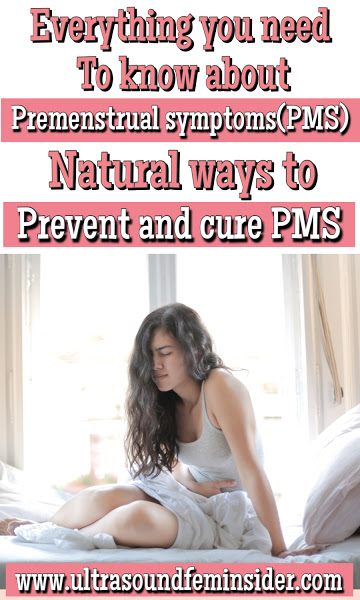Premenstrual symptoms or PMS symptoms was once dismissed as something that was just in our heads, but premenstrual syndrome is finally acknowledged as a real disorder. PMS affects women in different ways making us edgy, emotional, crampy or bloated. Up to 80 percent of women of childbearing age suffer from PMS. It usually strikes women in their mid-20s and tends to get worse as they get older, until they finally stop menstruating altogether when they reach menopause.
Premenstrual dysphoric disorder, also called premenstrual disorder, is a more severe form of PMS that affects 5 percent of women in their reproductive years. Women with PDD are so negatively impacted by mood changes such as anger and depression that they have difficulty functioning. In this post I am going to give important tips to manage your premenstrual symptoms or PMS like a pro, so you can feel better during that time of the month.
Symptoms of Premenstrual Syndrome.
Almost 150 physical and behavioral symptoms are associated with PMS which also complicates the diagnosis process and also makes it difficult to classify the condition as a specific disease. Symptoms for PMS can begin from anytime after the ovulation that occurs approximately two weeks before the start of your menstruation cycle. During the last three to fourteen days of your cycle whereby you can notice various changes in your body that could also lead to some degree of distress.
The symptoms of Premenstrual Syndrome or PMS may include:
- Swelling and tenderness in the breasts.
- Temporary weight gain of some pounds.
- Skin blemishes or acne.
- Headaches, nausea or constipation followed by diarrhea at the onset of menstruation.
- Increase in appetite or thirst, craving for certain food items such as sweets or items with high quantity of salt.
- Increased irritability or mood swings.
- Fatigue or insomnia.
- Confusion or forgetfulness.
- Feelings of anxiety or loss of control, sadness or uncontrolled crying etc.
Here you have 11 Natural Ways to combat premenstrual symptoms or PMS.
1. Keep Track of PMS symptoms.
Writing a symptoms diary can help. Recognize what’s going on throughout the month by taking notes of how you feel from day to day. You can then schedule things to coincide with specific times. For example if you tend to feel great for a few days during your cycle, that’s the time to take your driving test, or go to a job interview etc.
2. Tackle the PMS symptoms.
Many PMS symptoms can be easily controlled using natural remedies. For acne try taking a 15mg zinc tablet each day. Feverfew is great to treat migraines. Women suffering from bloating can benefit from burdock root capsules.
3. Take vitamins and minerals.
Studies show that a lack of various nutrients can increase PMS symptoms. These include magnesium, calcium, vitamin D and B, iron and zinc. In one study, it was revealed that 50-80% of women with PMS were deficient in magnesium.
Magnesium: Its been documented that women with PMS are often deficient in this muscle-relaxing mineral, which could account for some of their symptoms.
Vitamin B6: A large clinical research shows that vitamin B6 helps relieve premenstrual symptoms. In fact, a review trial found that B6 is twice as likely as placebo to provide PMS relief.
Vitamin C: If you experience heavy bleeding during your menstrual cycle, fragile blood vessels could be to blame. Vitamin C helps strengthen blood vessels, making them less likely to leak.
4. Lose excess weight.
Several scientists have discovered that the more overweight you are, the more likely you are to suffer from PMS. Also Start avoiding salt for the last few days before your period start, as it would reduce bloating and fluid retention.
5. Chill out.
Stress is also implicated in PMS. You are more likely to have worse PMS when you are stressed than when you are relaxed. Practice ways of relaxing.
Also many women experience emotional changes that make them feel low during the days before their periods. In some women, these changes may be mild and transient, disappearing with the onset of a period. In other women, emotional symptoms may be severe enough to interfere with normal activities. Common symptoms are depression, anxiety, irritability and aggression, resulting in what is sometimes called the PMS blues.
Many of the emotional symptoms of PMS experienced by women are thought to stem from the brains reduced ability to utilize a chemical called serotonin during the premenstrual phase. Serotonin has a mood-enhancing effect. That’s why is very important to relax, find and practice something that makes you feel happy and motivated.
6. Get Moving.
Exercise can lift you mood as it helps to boost the feel good chemicals in the brain known as Endorphins. Low levels of endorphins have also been implicated in PMS.
7. Snack more during the time of PMS.
According to researchers, your body needs 500 extra calories a day in the run up to your period as that is when your iron levels are at their lowest. On those days, is recommended to have a healthy mid morning and mid afternoon snack.
8. Consider doing these things:
- Have smaller meals to keep your blood sugar level steady and also prevents the craving for sweets.
- Drink plenty of warm water, coconut, raisins, papaya and sweet juicy fruits.
- Avoid saturated fats like red meat, cheese and butter as it increases the bad prostaglandins level causing uterine discomfort, bloating and mood swings.
- Suffering from cramps, drink a cup or two of red raspberry leaf tea. For bloating drink a cup or two of dandelion tea. If suffering from both drink both teas.
9. Take essential oils.
Some studies suggest that gamma linolenic acid (GLA) helps to reduce PMS symptoms such as irritability, stomach cramps and breast pain. You can find it in evening primrose oil, starflower oil and blackcurrant oil.
Use oils like evening primrose, borage, flax seed and pumpkin seed which contain Essential Fatty Acids (EFA). You can have primrose oil daily 3 to 6 grams. You can also use one tablespoon flaxseed oil for salad dressing.
10. Take herbs.
A plant called Agnus cactus is popular in the treatment of PMS. Research suggests it can improve symptoms by more that 50 percent. Chaste tree berry (Vitex Agnus Castus) is an herb, used immensely to reduce PMS problems. Take 10 drops of chaste tree berry extract every morning from mid-cycle until your period begins. It may take a nearly three months to see the results.
St John’s Wort can also help, but it can reduce the effectiveness of the contraceptive pill.
11. Cut this food out.
Salt, sugar, coffee and alcohol have all been linked to PMS symptoms. Salt causes bloating, alcohol can worsen your mood, caffeine can increase breast tenderness and sugar exacerbates food cravings.
Enjoying the post? Share it for later.
Relieve PMS with the Food Diet Changes.
- Reducing salt, alcohol and caffeine for a few days before your period should help with the bloating and mood swings. Some women have been helped by limiting sugar during this week as well. Be sure to get plenty of vitamin B-6, which can be found in green leafy vegetables, nuts, fish, poultry and potatoes. Vitamin E has also been found to have a positive effect on premenstrual symptoms.
- Research has shown that the consumption of fat increases estrogen levels, so reducing the amount of fat that you consume will help normalize estrogen levels and ease premenstrual syndrome. Increasing your intake of whole grains and fibers will help your body to eliminate the excess estrogen in your system. Combine the two and you have a powerful weapon against cramps and bloating.
- Calcium has also shown significant results when used to treat premenstrual symptoms. Taken with manganese and vitamin D, calcium aided in concentration, reduced cramping, bloating and mood swings. You can get plenty of dietary calcium in green leafy vegetables and legumes.
- Evening primrose oil has also been used to treat premenstrual syndrome. It is rich in omega 6 fatty acids that seem to act as an anti-inflammatory in the body, helping relieve cramps. These fatty acids are found in salmon, mackerel and tuna as well as safflower, sunflower and grapeseed oil.
Before turning to prescription or over-the-counter medications for premenstrual syndrome, try making some dietary changes. You may get to feel better quickly, without having to take any pills.
Related posts that might be helpful to you:
Irregular periods. Causes, treatment, natural remedies, ultrasound and more.
Understanding perimenopause and menopause.
Hemorrhagic cyst. When to be concerned.
Endometrial hyperplasia. Ultrasound included.
Pelvic pain in women. Role of ultrasound diagnosing pelvic pain.
Final thoughts about PMS.
Keep in mind that there are also certain unrelated medical problems that could mimic PMS symptoms and can mislead you or your physician. These medical conditions might include: fibrocystic breast changes whereby non cancerous lumps are formed in the breast that are swollen and painful. endometriosis whereby the tissue from the lining of the uterus causes pain anywhere in the lower abdomen, unrecognized pelvic infections such as Chlamydia, dysmenorrhea or painful menstrual cramps that could prompt nausea and diarrhea, diabetes causing excessive thirst and hunger, endocrine disorders such as overactive thyroid, emotional disorders that could be confused with mood swings during PMS or any other sort of allergies. Always consult your doctor to Rule out any other serious medical conditions.
If your symptoms are related to PMS, I hope this tips help you to feel better during that time.
Zadi, xo
Disclaimer: The medical information on this post is for educational and entertainment use only. Under no circumstances, this information is to replace your doctor’s advice or to treat any disease. For proper care, always visit your doctor.











This was an exemplary look at this issue. It is definitely a subject that’s worth paying attention too and it is great to see your take on it Zadi.
Is scientifically proven that is not in our heads only !!!
Absolutely, no doubt about that my friend <3
Great article with outstanding information, thank you so much.
I am glad to know it was helpful!
Hey, you used to write magnificent, but the last few posts have been kinda boring?I miss your great writings. Past few posts are just a bit out of track! come on!
I am so happy to read this. This is the type of manual that needs to be given and not the accidental misinformation that’s at the other blogs. Appreciate your sharing this greatest doc.
Nice blog here! Also your web site loads up fast! What web host are you using? Can I get your affiliate link to your host? I wish my website loaded up as fast as yours lol
Greetings from Ohio! I’m bored to tears at work so I decided to check out your site on my iphone during lunch break. I enjoy the knowledge you present here and can’t wait to take a look when I get home. I’m amazed at how quick your blog loaded on my mobile .. I’m not even using WIFI, just 3G .. Anyways, excellent site!